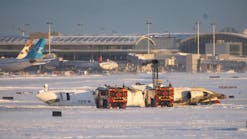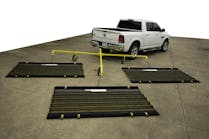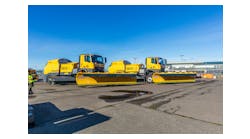A recently retired air traffic controller is complaining about an erratic guidance system for planes landing on one of Metro Airport’s runways, raising serious questions about its safety especially during bad weather.
Federal aviation officials stopped using the system in 2015, after less than a year of operation. But they resumed using it in 2018.
In an official statement, the Federal Aviation Administration told the Free Press last week that it would keep using the system because the agency had put safeguards in place.
But those safeguards were deemed inadequate in a high-level report, which was recently sent to President Donald Trump by the U.S. Office of Special Counsel. The report said that although the FAA tried to discredit air traffic controller Vincent Sugent, his concerns were fully supported by a detailed review of the FAA's own studies, as well as by the problems some pilots have encountered while landing with the runway’s troubled guidance system.
The August 5 report from the Office of Special Counsel, signed by Trump appointee Henry Kerner, who heads the office of high-level investigators, concludes that “safety issues are unresolved” and that the FAA’s claims of having put safeguards in place “do not appear reasonable.” The report urges the FAA to “take the steps necessary” to resolve the safety concerns raised by Sugent, 56, of Ypsilanti Township.
The issue is worrisome enough, and Sugent even in retirement has been so relentless as a whistleblower, that U.S. Sen. Gary Peters asked FAA officials to discuss it earlier this month with Peters’ staff.
Afterward, Peters told the Free Press in a statement:
“Whistleblowers play an important role in oversight (and) we must ensure their claims are thoroughly investigated and procedures are followed to ensure their protection. In light of the Special Counsel’s conclusions, I instructed my office to follow up with the FAA and the Senate Commerce, Science, and Transportation Committee, as well as third-party stakeholders, to ensure safety procedures at DTW are strong and being followed accordingly.”
DTW is the official airport code for Detroit Metro Airport. Peters is a member of the Senate Subcommittee on Aviation and Space, giving him unique standing among Michigan’s lawmakers in Washington to request feedback and seek changes from the FAA. Representatives of Sen. Debbie Stabenow and U.S. Rep. Rashida Tlaib also attended the FAA meeting with Peters’ staff.
In that meeting, Peters’ staff urged FAA representatives to revisit the issue, and in particular to go over it with “outside stakeholders” including members of the air traffic controllers’ union — the National Air Traffic Controllers Association, or NATCA. Independently, Peters’ staff had already contacted the controllers union, a spokesman in Peters' office said.
Sugent, the former president of the union’s local at Metro Airport, representing about three dozen employees there, said he was relieved. At long last, his concerns were making waves. He learned of the runway issue in 2015, was relieved that year when managers shut down the worrisome guidance system, and then lodged an official complaint soon after it was turned on again in August 2018, he said.
At age 56, Sugent retired in September after working at Metro for 24 years and for a previous 12 years at other airports, including five years directing military aircraft while in the U.S. Navy, stationed in Alaska and California.
Although these days he's happily distracted by visiting grandchildren, he still keeps file cabinets jammed with documents about his years of voicing complaints on behalf of coworkers, his union and airport safety, he said.
In 2010, Sugent was named Special Counsel Whistleblower of the Year, after succeeding in multi-year demands for several health and safety complaints. One led to a multimillion-dollar fix at Metro’s control tower to eliminate black mold. Another put a stop to pilots who'd been filing revised flight plans but failed to cancel their original plans, causing potentially hazardous confusion about aircraft routes — a beef whose correction “went national,” Sugent said, with a touch of pride.
Now, although retired, he wants one more victory. He showed the Free Press reams of FAA reports he’d obtained about the uneven performance of one runway's guidance system. In some FAA reports, Sugent was accused by managers — whose names were redacted — of trying to “sabotage” the runway’s performance, of wanting to foster fear, or of seeking to cost ailing airlines their slender profit margins. None of that's true, he said.
“I actually don’t care if an airline is going to lose money. My priority is the safety of the flying public and the flight crews,” Sugent said. In criticizing the troubled guidance system on Metro’s westernmost runway, Sugent said he isn't trying to provoke fear.
“I’m not saying, anytime you land an aircraft on it there’s chaos. I’m just saying, let’s make it safer,” he said.
Money does enter the issue, however.
It would require a significant expense, although no official document states an amount, to move the runway's problem-plagued guidance antenna to a location that would eliminate interference caused when planes taxi past it and airport vehicles roll by it, blocking its signal from incoming planes.
Alternatively, the FAA could simply stop using the equipment. That would make the airport less efficient because the guidance antenna lets Metro run at full tilt — able to land three aircraft simultaneously, even when weather conditions require instrument guidance rather than visual guidance. The FAA likes having that option available. As the agency says in its documents answering Sugent's complaints, it wishes to utilize “triple simultaneous approaches to maximize airspace efficiencies.”
More: Man dies after falling 6 stories at Metro Airport's Westin Hotel atrium
In clear weather and favorable winds, that’s not much of a problem. But the guidance system becomes an issue when the airport’s controllers must advise three incoming planes to land simultaneously while using instrument flight rules due to poor weather. When weather is poor, either night or day, pilots rely on electronic signals to guide them to runways. Until 2015, Metro had been allowing two planes to land simultaneously in poor visibility, both using their runway's instrument landing systems. Then, as the economy boomed in the years after the end of the Great Recession, airlines at Metro sought increased capacity for take-offs and landings. The FAA responded in 2015 by adding an instrument landing system to Metro’s third, and westernmost runway.
Because that runway is slightly closer to an adjacent runway than is usually allowed at major airports, the instrument landing system used a specially adapted version, called an offset localizer. The “offset” installation was designed to allow incoming aircraft headed for the westernmost runway to maintain their usual, required spacing from planes headed for the adjacent runway while they were high in the air and miles away, only squeezing them close together as they came in for landings.
More: Amazon to bring 1,000 jobs near airport, smack dab on former horse track
The typical instrument landing system has a localizer antenna positioned at the far end of a runway, sometimes called the “stop end,” beyond where aircraft exit a runway after landing. The typical arrangement transmits a signal right down the center of the runway, guiding pilots who are still miles away as to exactly where they should land.
In contrast, an “offset localizer” is not aligned with the runway’s center line. Instead, it sends a signal at an angle, to allow for converging flight paths of the incoming planes. At Metro, planes approaching Metro’s westernmost runway and its adjacent one do so in lines that are not quite parallel, before they squeeze together just while landing. To achieve that extra spacing in the air, the “offset localizer” sends a signal that is projected not down the center of the runway but, instead, at a slight angle away from the center.
That means the offset localizer’s antenna must be placed slightly off to the side of the runway, in a position where airplanes on the ground may slowly taxi past it, and where airport trucks may creep past it, through a so-called “critical area.” Each time a large object passes through the “critical area,” it can interfere with the antenna’s signal. When that signal interference occurs just as a pilot is approaching Metro at hundreds of miles an hour, and in poor weather or unfavorable winds, there’s a potential for trouble — even tragedy, Sugent said.
In its first year of operations, ground interference with the offset localizer led FAA officials at Metro to switch it off. Several pilots had experienced interrupted course guidance, overshot the runway and were forced to abruptly circle the airport to approach again, according to FAA records. But the airport resumed using it in late 2018.
The runway in question roughly parallels I-275 at the western perimeter of the airport. When incoming pilots lose contact with it, their high-speed jet airliners can quickly drift off course.
“They laterally start getting too close” to other planes, Sugent said. His laptop computer contains recorded conversations of pilots, overheard speaking with Metro’s tower controllers during and after such incidents. He played back several of the recordings for the Free Press. In one recording, the pilot affirms with the controller just after landing that he’d had trouble receiving the guidance signal.
“Yes, that was part of why we had some issues with the course. We were getting an intermittent signal from the localizer on the final,” the pilot said. The reference to “final” means the aircraft’s final approach, which is the segment of landing when a plane is lined up with a runway and ready to land. Sugent said he checked logs of the incident and learned the cause.
“During the intermittent signal, there was a vehicle on the runway, doing an inspection in an area that we’re talking about. Incidents like this would never have happened if we hadn’t been introducing risk” with interrupted signaling from the offset localizer, he said.
In May 2018, according to an FAA memorandum, an internal panel of agency experts decided that Metro’s offset localizer was safe to use as long as the airport imposed two conditions: First, controllers would not use the system and not attempt triple simultaneous landings when the weather forecast called for “less than 800-foot ceiling” — a low height of cloud cover — and “less than two nautical miles visibility,” which means a sight limitation of slightly more than two conventional miles. Second, it would not allow landings on the runway while using the off-set localizer by any aircraft with a high tail design, known to interfere with the signal.
Yet, in December of that same year, another FAA memorandum rescinded the weather restriction. And evidence going back to 2015 showed that the interference could occur even with aircraft that have lower tail heights, according to the Special Counsel’s report.
In a memo in March of this year, in which the FAA responded to the Special Counsel’s lengthy investigation, the agency said it had all but quit using the offset localizer this year because there was little need for it during the pandemic. It said the airport’s volume of activity had dropped more than 50%, “due to airline schedule reductions,” and so there was no longer any demand to land three planes simultaneously using instrument guidance systems, and thus no need for using the offset localizer.
The FAA memo went on to give another reason: It said that using the offset localizer to allow for three simultaneous landings required putting air traffic controllers and other personnel “in close physical proximity, compromising the urgent need to maintain adequate social distancing to the extent possible to protect employees” from the spread of COVID-19. So, for health as well as safety, the offset localizer had been idled.
Yet, by November, the FAA was again using the troubled system. The agency told the Free Press, and told the U.S. Office of Special Counsel during its investigation, that it had taken steps to reduce risks associated with the offset localizer, including efforts to educate pilots about the unpredictably intermittent signal. But the report from the Office of Special Counsel said those safeguards weren’t adequate.
“The evidence presented does not support FAA’s conclusion that ‘comprehensive safeguards are in place to address all safety concerns,’ and even with greater pilot awareness, recent incident reports suggest the safety issues are unresolved,” the report said.
Besides going to President Trump’s desk, that report went to key senators and members of Congress on the committees that deal with aviation on Capitol Hill. Sugent also got a copy.
“I may be retired, but I’m not done with this,” he said.
Contact: [email protected]
This article originally appeared on Detroit Free Press: Whistleblower claims runway at Detroit Metro Airport unsafe
___
(c)2020 the Detroit Free Press
Visit the Detroit Free Press at www.freep.com
Distributed by Tribune Content Agency, LLC.





